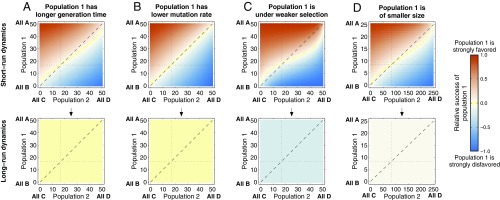Fig. 3.
Evolutionary dynamics of mutualisms when is large and population 1 evolves slower than population 2 owing to (A) a longer generation time, (B) a lower mutation rate, (C) weaker selection, and (D) a smaller population size. Population parameters are the same as in Fig. 2, but now . A short-run Red King effect is observed for generation time, selection strength, and population size, with that for selection strength most pronounced. These short-run Red King effects are analogous to those found by B&L (26). Relative differences in mutation rate have no discernible short-run effect. In the long run, differences in mutation rate and generation time have no effect on the relative success of the populations, whereas a Red Queen effect is found for selection strength and population size.

